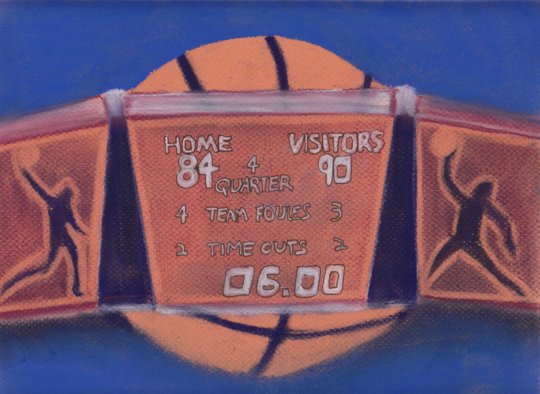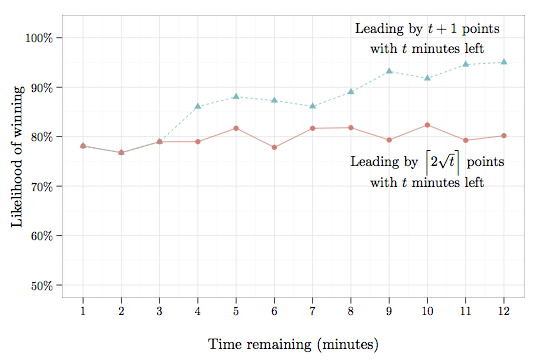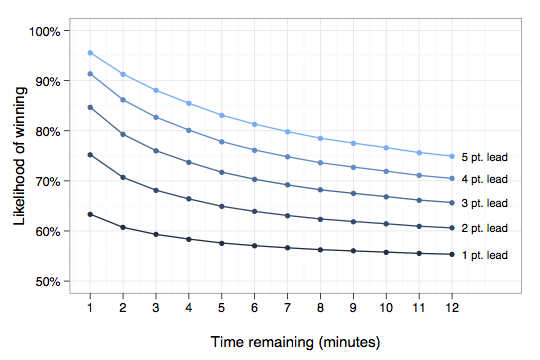How Close is Close
Messy Matters 2013-03-15

Your team is down by a couple of baskets going into the final minutes of the game. Is it time to panic or is it still anyone’s to win? Plenty have certainly come back from apparently dire situations. Just last month the Lakers beat the Thunder in double overtime after being down by 11 points with four minutes on the clock. In fact, such comebacks have led the renowned sport statistician Bill James to conclude that with four minutes remaining it’s not really over unless the gap is at least 19 points.[1]Spectacular reversals of fortune may be rare, but conventional wisdom holds that a lot can and does happen in that last quarter.
“An NBA team leading by twice the square root of minutes left in the game has an 80% chance of winning.”
As explained by Moneyball author Michael Lewis, “one statistical rule of thumb in basketball is that a team leading by more points than there are minutes left near the end of the game has an 80% chance of winning. If your team is down by more than 6 points halfway through the final quarter, and you’re anxious to beat the traffic, you can leave knowing that there is slightly less than a 20 percent chance you’ll miss a victory.” While that’s a compelling heuristic, an analysis of over 7,000 games over the last six seasons reveals that it only holds for a few short minutes, losing accuracy even by the six-minute mark in Lewis’s example. A better rule of thumb is that a team has an 80% chance of winning if they lead by twice the square root of minutes left. Going into the final quarter (12 minutes) of the game, for example, that 80% threshold is achieved at \(2\sqrt{12} \approx 7\) points. By comparison, the standard heuristic suggests a substantially larger gap of 13 points is required to achieve an 80% chance of success.

Why does the square root rule work? Basketball games can be reasonably well modeled as a series of independent one-minute rounds consisting of approximately one possession for each team. In each interval, the score differential between the teams changes by about two points, with each team roughly equally likely to win that round. In statistical terms, the intervals are approximately mean 0 with standard deviation 2. The central limit theorem then shows that with \(t\) minutes remaining, the score gap changes approximately according to a normal random variable with mean 0 and standard deviation \(2\sqrt{t}\). (By contrast, the rule of thumb Lewis cites implicitly — and incorrectly — assumes randomness increases linearly in time.)Since it is unlikely a team will make up a one standard deviation deficit (i.e., \(2\sqrt{t}\) points), a lead of at least that much is relatively safe.
It’s perhaps surprising that a seemingly modest seven-point deficit is difficult to recover from with a full quarter of play remaining. Granted, coming back 20% of the time is not exactly a snowball’s chance in hell (more like the chance of sunshine in Juneau, in December), but it’s certainly not an enviable position to be in. The data further show that even starting the fourth quarter down just five points does not bode well, with only a 1 in 4 chance of success.

At least anecdotally, there appears to be a general sense that entering the final stretch down a few points is not a big deal; it’s still a “close” game and anything can happen. Understanding the effects of such deceptively minor deficits, however, could lead to better strategic play.For example, a team that correctly recognizes their low likelihood of success may attempt riskier plays so as to increase the randomness of the game and in turn boost their chance of winning. Alternatively, realizing the point gap amassed in the first three quarters is in fact quite consequential, teams may increase their intensity of play earlier on. But who really knows if such armchair statistical strategies would actually work in practice? Certainly not me — I’ve never even played a proper game of basketball — but that hasn’t stopped me from blogging about it before!
Footnotes
[1] Strictly speaking, James’s rule was intended for college — not professional — basketball, but I suspect he would arrive at a similar estimate for NBA games.
Illustration by Kelly Savage. Data obtained from BasketballValue.com. Thanks to Kiran Limaye, Dave Pennock, Matt Salganik, and Sid Suri for teaching me that basketball is the one in which you try to put the 2-sphere through the 1-sphere.